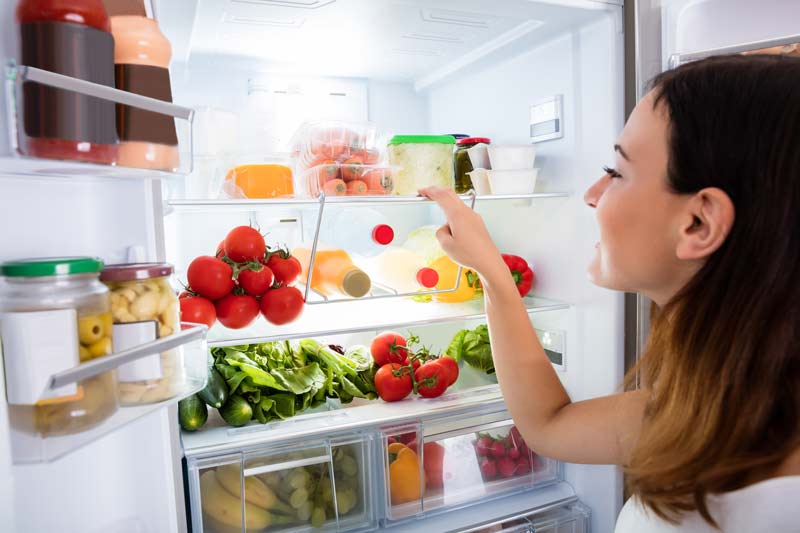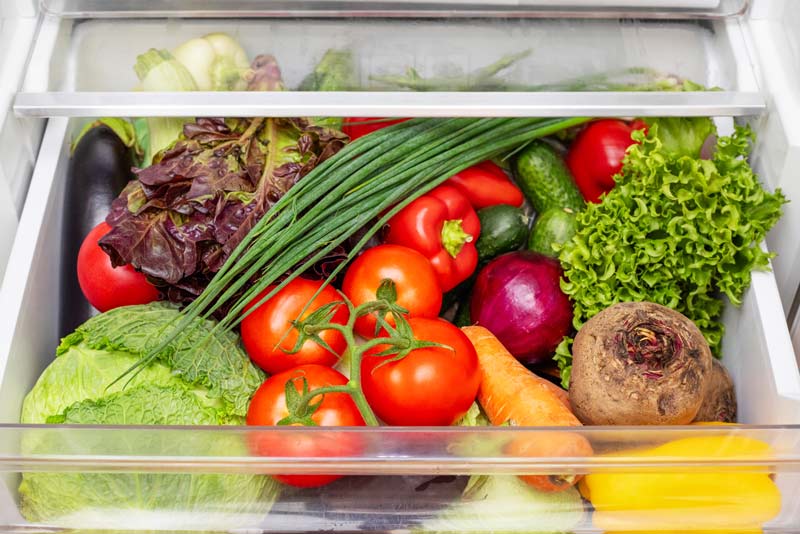A fridge is one of the most hard working appliances in your kitchen and one we use multiple times every day. It makes sense to look after it, but could your fridge be better organised? An organised fridge can improve your life in so many different ways. You'll be able to:
Successful fridge organisation relies upon the correct use of different areas in the fridge, for specific types of food.
Here's a quick summary of how to organise your fridge by zone, we go into much more detail below:

1. How to organise a fridge
Refrigerators are designed to help keep food fresher for longer. Fresh food will begin to deteriorate rapidly if the temperature is too warm and bacteria begins to multiply. This can lead to food waste and food that's not safe to eat. When you store food in a cold fridge, bacterial growth slows down, or even stops, resulting in food which stays fresh for longer and is safe to eat.
What’s the correct temperature for a fridge?
The correct temperature for your fridge is between 1-4 degrees celsius. Temperature fluctuations throughout, means you need a well organised fridge to ensure you are storing food correctly.
What you should keep on the top shelf
The top shelf is one of the warmest parts of the fridge and should be no higher than 4 degrees celsius. It's perfect for storing cooked food, leftovers, condiments, sealed jars of opened pickles, sauces and other foods that are ready to eat.
Leftovers and cooked food must be stored in covered containers or glass jars to prevent them from drying out and spoiling from bacterial contamination. Never put hot food into your fridge. It can cause the fridge temperature to rise and can provide the perfect conditions for bacterial growth which can lead to food poisoning.
If your upper shelf is very full, a Lazy Susan or turntable can improve access to items right at the back of the top shelf. Never put hot food into your fridge. It can cause the fridge temperature to rise and can provide the perfect conditions for bacterial growth.
What you should keep in the middle shelves
Store all of your dairy produce, including butter, cream cheese and softer dairy items like yoghurt on the middle shelf of the fridge. An unopened milk carton or milk bottle can also be placed in this space.
Deli meats and cheese should be kept cold, at a temperature of 2 degrees celsius, to prolong their life and keep in perfect condition. Eggs can be stored in an egg tray on the middle shelf or on the bottom shelf of the fridge door.
What you should keep on the bottom shelf
Raw meat and fresh raw fish should always be kept on the lower shelves of your refrigerator. This is the coldest part in many fridges, with the lowest temperature just 1 degree celsius. Always store meat and fish in their original packaging, which states the correct use by dates. If you do remove the packaging, remember to label the new container with the specified use by dates.
Remember to always place fresh chicken and raw meat on a tray or glass dish and cover it, to prevent it from dripping blood onto food below. This will also prevent strong smells from tainting other food in the fridge.
Never put raw meat above cooked food, as this could cause cross contamination of bacteria and potential food poisoning.
If you are defrosting meat or fish in the fridge from frozen, the bottom shelf is the perfect temperature to do this. Once again, remember to place on a tray or dish to collect any liquid or blood which might be released when defrosting.
What you should keep in the drawers
Many refrigerators have drawers at the bottom. These are designed specifically to keep fresh fruit and veggies and fresh herbs, in perfect condition.
A crisper drawer aims to prevent vegetables from becoming limp. A humidity control, available in some fridges, will ensure the optimum drawer environment, so fresh produce stays fresh and doesn't spoil.

Many of the new French door refrigerators take this a step further. They are now moving the vegetable drawer, out of the main cabinet and into a separate temperature controlled storage zone beneath. These are proven to prolong the life of fresh fruit and veggies
What you should store in the refrigerator door
It's okay to store milk in the fridge door. Milk bottles, fresh juice, beer and wine bottles are all best placed in the door shelves, with salad dressings and bottled sauces. These items are fine with a slightly warmer temperature and can handle the temperature fluctuation, when the door is opened and closed throughout the day.
2. How to keep food fresh for longer
In a well organised fridge, the food you store in your refrigerator needs to be wrapped or placed in a storage container. This will stop it from drying out and becoming stale very quickly. It should then be labelled with the date and stored, in the recommended temperature zone, to maintain its freshness.
An airtight container like those available from New Zealand manufacturer Sistema will help you get your fridge organised. These are perfect for storing and safely freezing fresh food. The range includes multiple sizes and shapes to suit every need. See everything in your fridge at a glance with these transparent organiser bins with lids.
3. How to organise your fridge to reduce food waste
If you're on a budget, you don't want to have to throw food out. Labelling your food is a great solution and we recommend labels with use by dates. Label your containers with a sticker, stating the day it was opened and when it should be used by. You can buy preprinted labels online, or write the dates with a permanent marker, onto masking tape, then stick to the container.
Keep a checklist on your fridge door
When we're busy it's easy to forget what food needs eating first. Keeping a checklist on your fridge door will help you keep track of your food and reduce the amount of food waste going into the bin.
Plan a weekly menu
Planning the weekly menu in advance can also help limit waste. Plan dishes around your fridge contents and use last week's leftovers first, before shopping for more.
Freeze leftovers immediately
If you're unlikely to eat leftovers within the following 3 days, then we recommend you cool it rapidly and freeze immediately to avoid wasting it.
4. Keep your fridge clean
Finally, we recommend you keep your fridge scrupulously clean. Wipe up stains and spills as they occur. Clean sticky sauce bottles when you use them. Go through your fridge at least once a week and toss spoiled food into the bin. You should also wipe door handles daily and after cooking, with antibacterial detergent, to remove bacteria from dirty hands and fingerprints.
At least once a month, empty your fridge of all its contents and give it a thorough clean. Wipe the inside with hot, soapy water, wipe with clean water and dry off with a clean towel. Remove all the shelves and drawers and soak in hot soapy water, using a toothbrush to get into tight corners and grooves. Then rinse and dry.
Then it's time to sit back, have a cup of tea and admire your clean, beautifully organised fridge.
